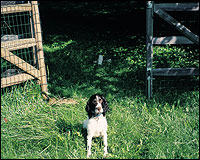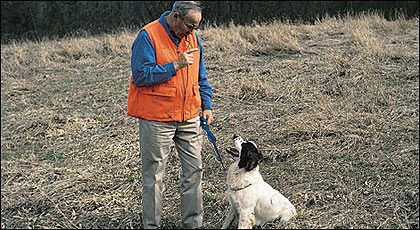Set your dog on the right course and he'll perform to expectations while afield.
By John McGonigle
There is no way to sugarcoat it: training gun dogs takes time and repetition. The results of your training efforts, though, bring happiness and satisfaction to both you and your pup.
Hunting dogs are made in the back yard, not in the field. I know you can't train a bird dog without birds; that's true enough. But if you cannot control your dog it does not matter if he can find birds because he will be hunting for himself and be of no value to you.
Most hunters are similar to most athletes; neither group likes to practice, but they would rather just play the game. The Philadelphia 76ers' Allen Iverson, one of the most talented athletes in the National Basketball Association, created team disharmony because he often failed to show up for practice on time, saying that it was "only practice." So it is with us; we'd rather just take our dog hunting opening day and "play the game."
I have failed my share of gun dogs because of not putting in the time. One became a great frisbee dog for a neighbor's family and one was put down because, in addition to problems I helped create, he developed a mean, sneaky streak and could not be trusted around youngsters.
 Spaniels quickly learn that a fenced training area demands compliance. |
Good trainers, including professionals, do the most important part of their training in the yard. They are successful because they provide repetition and consistency, both necessary ingredients for good, reliable results in the field. Want your dog to retrieve reliably, hunt a particular area as directed, and be steady? All of these things, and more, are taught in the yard.
Training in the yard provides a huge psychological advantage for you. Pup learns almost immediately that he cannot escape. He also learns quickly that compliance to your commands results in reward: petting, loving-up and occasional snacks.
Another huge benefit of yard training for pup is that he is never out of shotgun range; it is hard to overstate the importance of this. Pup will learn--actually be programmed to a large extent--to remain in range. Don't worry about him becoming a boot polisher (working too close); it's easy to get pup to range farther if necessary. Flushing dogs, though, must hunt within shotgun range€¦always!
Sit (hup), stay, come and heel, plus taking simple hand signals, are about all the commands spaniels need to learn. Learning "no" is a given; you will start teaching that as soon as pup arrives home. The three most important things about dog training are: repetition, consistency and remaining calm during training.
 Professional dog trainer Paul Harris of New Jersey takes time during yard training to lavish praise on his English cocker spaniel. |
The last one, remaining calm, is the tough one. We're only human, right? Everyone occasionally loses their temper, hollers, lets off some steam, maybe even hits or kicks a dog. Your canine friend, though, is only a dog. While his love is limitless his capacity to think is restricted, so we must do the thinking. Remaining calm is your job. Dogs have an amazing capacity to read and understand our emotions. If you remain calm, pup also will tend to remain calm. Thumbing through an old book recently, I read the best advice ever concerning hunting dogs; I apologize for being unable to cite the source. It is appropriate here, though, and goes something like this: When you get him, your dog thinks you are god. Never do anything to change his opinion.
Teach the basics: sit (hup), stay, come and heel in the yard, basement or garage. Train alone because young dogs are easily distracted. After progressing, train near either a kenneled or a staked-out dog; it can help them both. Later, train around another person to add distraction and to teach pup to obey under all circumstances.
Young dogs that respond perfectly at home alone often just ignore the heck out of you around other people. It's embarrassing, but it is our fault for not introducing him to distractions.
Spaniel folks say "hup," for sit; it is based on tradition but it's only a word. If you are more comfortable with "sit," use it instead. After playing with pup a few minutes and letting him run around, perhaps taking care of biological necessities, leash pup and walk him around briefly. Hopefully by now pup will walk on leash without fussing or pulling, even though he does not obey and/or walk to "heel."
Quietly say hup/sit and pull up on the (short) lead while gently pushing pup's rump to the ground. Keep the leash snug and pet pup gently for several seconds as he sits. Release pup before he decides to move on his own; it keeps things on a positive note. Extend the time pup sits and use an accompanying hand signal (your hand up with the palm facing pup) so he learns two commands for sit: the verbal command and the hand signal. Once pup has mastered the verbal command, add a single toot on a whistle to teach him to sit to the whistle. Repetition teaches pup to sit, and to stay.
"Stay" need not be a separate command, as it is really an extension of "sit"; pup should sit until being released. After he remains seated for several seconds, move a step or two from him and, keeping your hand up and palm facing him, make him wait a bit longer. With repetition and praise for doing his job, pup will learn to stay until released.
 A mentor, the late Ed Berger, works "hup" and "heel" on a short lead. |
Gradually increase your distance from pup as well as the time he must sit, using a lead as needed. You should eventually be able to go around the side of the house or hide behind the garage so that pup cannot see you and he should remain sitting. Obviously, this takes repetitive practice; we're talking about several months. Return to pup before releasing him from an extended "hup." If you call pup to you while teaching him the extended "hup," he will constantly try to outguess when you will call him, causing him to "break," or move. Praise him by petting him gently; exuberant praise before the lesson is thoroughly learned often causes pup to break before being released.
If pup breaks, lead him back to the spot and
command hup/sit. Repeat as necessary.
Why go to so much trouble? Because it's nice to be able to sneak up to a small pond or creek while pup remains seated, waiting for your command, or gunshot, to race forward for a retrieve. It's a great way to hunt ducks; pup's obedience is the icing on the cake that makes the experience sweeter.
Teaching the command "come" is easy when you start with a young pup. When, as a young pup, he gets too far from you he will come running back to be by your side. Anticipate his return and say "come" just as he starts to race to you. When he arrives by your side, pet him and love him up so that he learns that returning is always rewarding. Again, use gentle petting, but let him know you are pleased.
Gun dogs from good breeding want to please you. That is one of the important benefits of a well-bred dog; use it to your advantage. As pup ages he may be preoccupied when you call him. Bend low and hold your hand towards him; that will generally get him moving in your direction. Sometimes having a doggy treat in your hand will work wonders, but keep him guessing; don't always offer a treat. Occasionally you might have to attach a long lead, rope or parachute cord to encourage pup when working on "come" from longer distances. Build on compliance and his successes and pup will come reliably on command; don't forget the praise and occasional treats.
When he's coming reliably, command "hup" when he arrives. Want him attentive and looking directly at your face when he comes and sits? Spit a small piece of hot dog or liver (yuck!) treat from your mouth. Soon he will look intently at your face when he arrives. Increase the time pup sits and the distance he must come when called, progressing slowly so that he is successful. Nothing succeeds like success in dog training; successful lessons are building blocks for future learning.
 Berger begins the prolonged "hup" on a light rope. |
Heeling is a positive behavior that keeps pup safe, keeps him from troublesome situations and offers an alternative to "come" on days he might have a burr under his saddle.
In recent years I started using a leather collar, with dull, blunt spikes to teach "heel"--no sharpening of spikes is necessary or desired. Even dull spikes impart the message to get with the program. Start with regular leash pressure to keep pup at heel while you say the command. After a month or so when pup knows what is desired but decides to stray, a short, quick jerk of the lead and spike collar quickly reminds pup to stay on task, i.e., pay attention and comply.
 After pup shows consistency on the prolonged "hup," Berger removes the rope. |
I start by heeling pup against a fence so he has no option but to walk by my side; it even works to teach turns. Once pup has caught on, move away from the fence. When stopping, give the "hup" command. When walking away say, "come"; do not let pup move without the "come" command because there will be times you want pup to remain seated. Remember those ducks?
Proceed until you can walk pup at heel, stopping, walking again and making turns with him at your side with a loose lead. Then it is time to discard the leash and begin over. Then go back on lead and heel him near another dog or a person. Increase the distractions until you reach the level of compliance you desire.
How long do we do yard work? The best answer to that question comes from the book, Charles Morgan on Retrievers, edited by Ann Fowler and D.L. Walters. In it the late Charles Morgan, an extremely successful pro, related, "When you are absolutely, 100 percent sure your dog has it right, continue drilling on it for another month." Lessons start in five- to 10-minute increments, increasing only to 20 minutes. Pups and trainers get bored easily; avoid boredom by having fun. The late Ed Berger, a wonderful friend and mentor, once told me, "Train by the tail, John--train as long as pup's tail is up." Remember to praise often, be consistent, remain calm, train frequently and always use short sessions.
Most of all, though, have fun with pup and you will have a longtime hunting partner who not only brings you birds, but also brings you joy.






